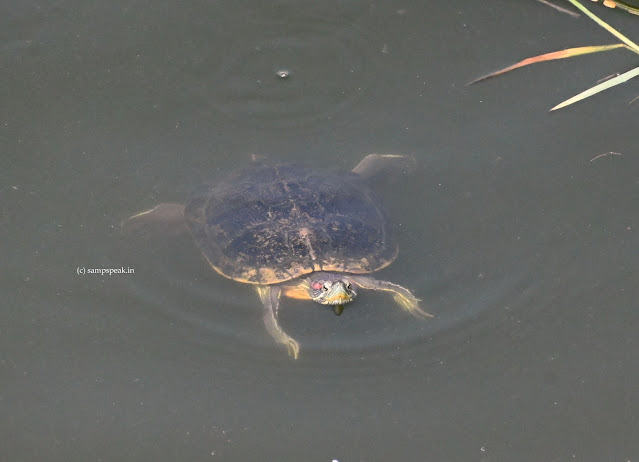The beautiful pond Kairavini (Triplicane temple pond) is home to some big fish, ducks, water birds, sparrows and more .. .. and .. .. and I found something else on a moat – zoomed my camera and took some photos – interesting ! – who let them in ? not native and for sure would have bred here !! someone have intentionally brought and let them inside !
Startled to see more than a couple of ‘Tortoise’ !! or are they Turtles
!! ~ who put them in ??
Turtles are among Earth's oldest creatures, predating dinosaurs. Over 350 species exist, many endangered due to pollution, poaching, and climate change. By some estimates, they have been around for about 200 million years, even before the dinosaurs! Today is ‘World Turtle Day’. This year's theme is Dancing Turtles Rock! Aquatic turtles live 20-50 years, while land turtles can live 50-150 years or more. Jonathan, born around 1832, lives on Saint Helena Island and is the world's oldest known living land animal. They're vital to the ecosystem. Avoid plastic, don't buy or sell them, and keep beaches clean.
World Turtle Day is an annual observance held every May 23rd. It began in 2000 and is sponsored by American Tortoise Rescue. The day was created as a yearly observance to help people celebrate and protect turtles and tortoises and their disappearing habitats, as well as to encourage human action to help them survive and thrive. Turtle or Tortoise !
All tortoises are
turtles— i.e., they belong to the order Testudines or Chelonia, reptiles having
bodies encased in a bony shell—but not all turtles are
tortoises Tortoises are exclusively land creatures.
They live in a variety of habitats, from deserts to wet tropical
forests. Modern turtles are divided into two major groups, the
Pleurodira (side necked turtles) and Cryptodira (hidden necked turtles), which
differ in the way the head retracts. There are 360 living and recently extinct
species of turtles, including land-dwelling tortoises and freshwater
terrapins. Turtles live in Sea, river and Ponds and occasionally
come out of water too!
Coming out of water is
not all that easy as experienced by Olive turtles - Under cover of
darkness, they swim harsh conditions, prepare the sea shore sand and
lay eggs - baby olive ridley turtles hatch from sun-warmed eggs on remote
beaches. They try to return to the sea and not all of them make it
back ! some lose their way, some get killed by predators ! –
it is not a life of charming existence !
There are many stories
involving tortoise, the most popular being its winning a race
against a hare. Then
there is this interesting story of ‘tortoise
flying’ and ‘speaking madly’ in Panchatantra. Once upon a time, there was a tortoise by the name of Kambugriva
and two geese by the name of Sankata and Vikata. When the local pond
dried up totally, the geese offered to shifting the tortoise by air,
with firm advice that it should keep its mouth shut throughout. The
geese took each side of a lengthy sticky, to which tortoise was to hang by
holding on its mouth…… midway, curious to answer, the tortoise spoke, opening
its mouth, letting off the stick in the process, fell down and
died……..
Moral : listen to friendly
advice and never speak when not required.
ஆமை புகுந்த இடம்
உருப்படாது என்பார்கள் .. .. ஆனால் நீர்நிலைகள் ஆமைகளின் இருப்பிடம். ஆமை பார்ப்பதற்கு
அப்படி ஒன்றும் அழகில்லை. . அது நம்மை ஏறிட்டுப் பார்க்கையில் அதன் கனத்த முதுகும்,
ஓட்டுக்கு வெளியே தெரியும் அதன் முகமும், நான்கு பாதங்களும் சற்று வித்தியாசமாகவே
இருந்தது. திருவல்லிக்கேணி கைரவிணி திருக்குளத்தில் இந்த ஆமை இளைப்பாறி
நம்மை நேருக்கு நேர் சந்தித்தபோது எடுத்த படம்.
Google image search reveals
the one pictured to be a terrapin – a variety known as ‘red-eared slider’
(Trachemys scripta elegans), a subspecies of the pond slider, a
semiaquatic turtle belonging to the family Emydidae. It is the most popular pet
turtle in the United States, is also popular as a pet across the rest of the
world, and is the most invasive turtle. It is the most commonly traded
turtle in the world.
Red-eared sliders (pls
do not ask where the ears are !) do not
hibernate, but actually brumate; while they become less active, they do
occasionally rise to the surface for food or air. Brumation can occur to
varying degrees. In the wild, red-eared sliders brumate over the winter at the
bottoms of ponds or shallow lakes. During this time, the turtles enter a state
of sopor, during which they do not eat or defecate, they remain nearly
motionless, and the frequency of their breathing falls.
Interesting !
Regards – S Sampathkumar
23.5.2025
PS: the last one was pictured in a zoo, rest in Triplicane koil kulam.
.jpg)

.jpg)
.jpg)
No comments:
Post a Comment